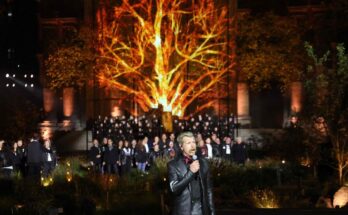A recent photo of Georg Friedrich Haas (Graz, 72 years old) in a well-known flamenco tablao in the center of Madrid is circulating on Facebook. “I am not exaggerating if I say that it was one of the most intense musical experiences of my life,” confesses the Austrian composer in a windowless room of the National Auditorium. “It seemed to me that this expressive freedom did not belong to any Central European ideology or canon.” Haas is the son and grandson of Nazis, so all his music comes from the survival instinct of what he describes in his memoirs as “inherited horror” during a childhood in which he suffered physical and sexual abuse. “My parents were criminals,” he says with absolute serenity. “I came to this conclusion after a long process of assimilation, marked by shame and fear. For years I couldn’t talk about it with words, only with music.”
From that need to exorcise his own ghosts were born In vain (2000), a monumental work that director Simon Rattle did not hesitate to consider the first masterpiece of the 21st century. Haas composed it when the far-right party his family belonged to came into government in his country. “I felt like everything we thought we’d overcome was coming back. Hence the title: in vain.” It will be the first work from his catalog to be performed within the cycle dedicated to him by the National Center for Musical Diffusion (CNDM), where this season he will be composer in residence. In it Haas uses a microtonal language to expand the limits of listening across a harmonic spectrum that seems to knock on the doors of another world. “What awaits us at the end of the journey is not paradise,” he warns. “Nothing like that.”
During Friday’s concert in the Chamber Hall of the Auditorium, which will be conducted by Jordi Francés, director of the National Youth Orchestra of Spain and some members of the Klangforum of Vienna, the lights will be completely turned off to reinforce the ritual dimension of the event. In vain. “That darkness is closely linked to the cultural tradition of Spain,” reflects Haas, who declares himself an admirer of Goya’s black paintings and El Greco’s “spiritual drama”. “But it also has a lot to do with a present that stealthily but relentlessly repeats the darkest patterns of our history. We cannot forget that Austria, Germany and the communist states became dictatorships not through war, but through a process of legal evolution. And that is exactly what is happening in the United States.”
In 2015, a year before Trump’s first electoral victory, which plunged him into a state of paralysis and incomprehension, the composer married, for the fourth time, the African-American artist and activist Mollena Williams, with whom he has lived since then in a Harlem apartment overlooking the Hudson River. They both parade naked (literally) through the documentary The artist and his perversionwhere Haas acknowledges his dominant sexual identity within a consensual BDSM relationship. Between whips, dildos and spankings, the musician celebrates in front of the cameras the achievement of an emotional and creative freedom “not at all incompatible” with his feminist beliefs. “My uncle joined the Waffen-SS to give free rein to his sadism. I turned that drive into love. I have nothing to hide. It’s better to be a pervert than a murderer.”
After the interpretation of In vain in Badajoz, this Sunday, the monograph will continue next year at the Auditorium 400 in Madrid, where you will be able to see some of the hallmarks of Haas’ unique style: the microtonal process of Tria ex one from the Renaissance polyphony of Josquin Desprez, the timbric richness of Anachronism or the internal dramaturgy of Tribute to Bridget Riley. On March 23rd the world premiere of his Saxophone Quartet No. 2a work commissioned by the CNDM which will be carried out by the Kebyart musicians. “I wrote it this summer in England as a tribute to Mollena’s father, who served as a Marine in the Vietnam War. Before that trauma, from which he never recovered, he played the saxophone in Times Square and worked hard so his children could study and travel in Europe.”
Haas was a student of Ivan Eröd, a Jewish composer who took refuge in Graz after the Hungarian revolution of 1956. “One day I went to visit him at his house and was alone with his mother for a while,” he recalls. “When I asked him about his other son, who I didn’t know had died at the front, I understood for the first time what the silence was: it was as if the room was collapsing under our feet.” Haas subsequently studied with Friedrich Cerha in Vienna, became friends with that “destroyer of beauty” called Helmut Lachenmann and even became acquainted with French spectralism during his time at IRCAM in Paris. In the end he found in the avant-gardes across the Atlantic the consolation that the theoretical dogmatism of the Second Vienna School had not been able to offer him. “Let’s say, to sum it up, you can’t love John Cage’s music and be a Nazi,” he says and laughs.



